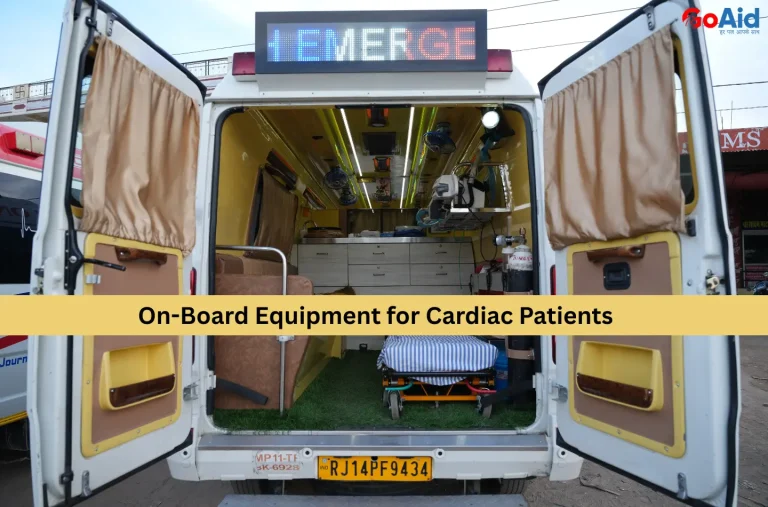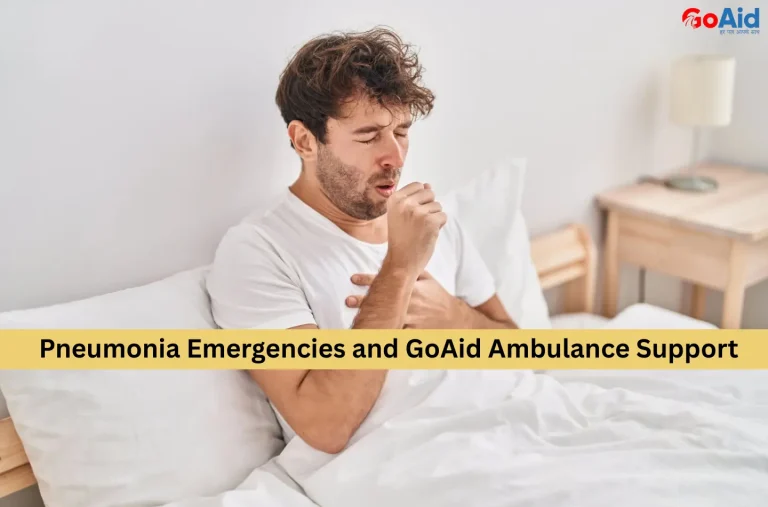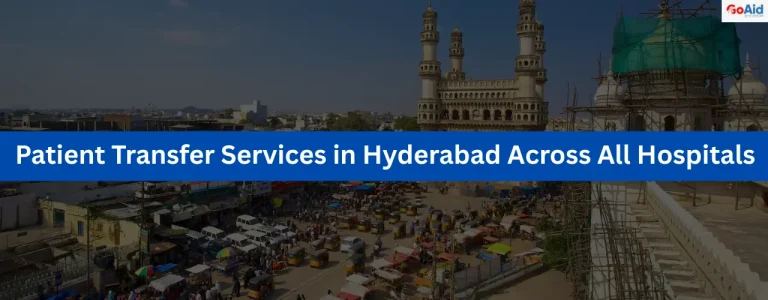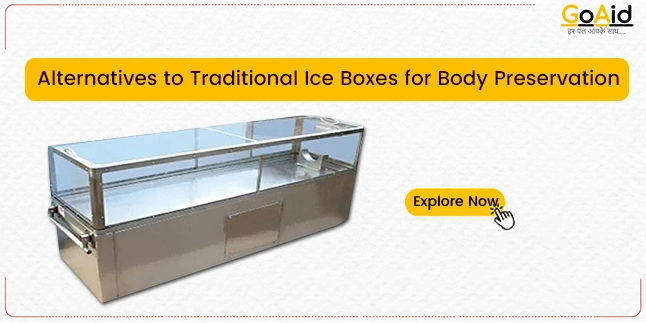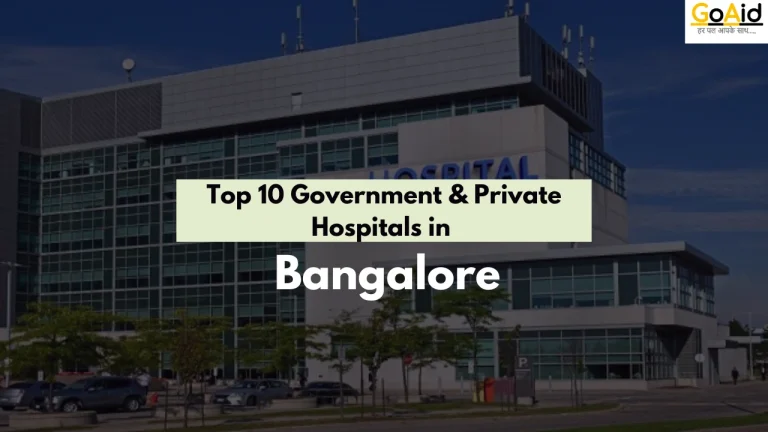In many cities, patients and families face delays, limited support, and inconsistent care when relying on government ambulance services. During emergencies, every second matters, and people naturally look for faster, safer, and more dependable medical transport options. This growing need for reliability is one of the key reasons patients increasingly prefer private ambulances.
This is why, in this blog we have provided you with all the details about how private and government ambulances differ, why private services offer quicker responses, what makes their care quality superior, how advanced vehicles help, why pricing transparency matters, and how GoAid builds strong patient trust. Do you want to know all these information in detail? then read our blog to the end.
So, lets start
Key Differences Between Private & Government Ambulances
Private and government ambulances both aim to save lives, but their service quality, response time, and reliability differ significantly. Government ambulances are often affordable yet face delays due to high demand, limited fleets, and administrative constraints.┬Ā
In contrast, private ambulances provide faster response, modern medical equipment, and more personalized care because they operate with better resource management. Patients also get clearer communication, flexible service options, and quick availability during peak emergencies.
Private services like GoAid ensure advanced life-support systems, trained paramedics, and GPS-enabled dispatch, which improves overall emergency efficiency. Meanwhile, government EMS may struggle with outdated vehicles, staffing shortages, and inconsistent service quality in crowded urban areas.
As a result, patients increasingly prefer private ambulances for their reliability, comfort, and transparent pricing, especially when every second matters. This shift highlights why private providers are becoming the trusted choice for emergency and non-emergency transport.
How & Why Private Services Offer Much Faster & Safer Response?
Private ambulance services outperform government ambulances because they prioritize speed, technology, and patient-focused care. Their operational flexibility ensures safer and more efficient emergency support.
1. Advanced GPS Tracking & Smart Dispatching
Private ambulances use real-time tracking and algorithm-based dispatching to assign the nearest available unit. This reduces delays and ensuring rapid arrival even in busy urban zones.
2. Well-Maintained & Modern Ambulance Fleet
Private providers regularly upgrade their vehicles and equipment. This ensures safer transport, better stability, and reliable functioning during emergencies without the mechanical issues often seen in government fleets.
3. Highly Trained Paramedics & On-Board Specialists
Private teams undergo continuous medical training. This enables them to handle trauma, cardiac cases, and critical care more efficiently, resulting in safer patient management during transit.
4. Lower Workload & More Focused Care
Government EMS handles huge public demand, but private ambulances manage fewer calls. This allows them to respond faster and deliver more attentive, patient-focused emergency services.
5. Priority Handling & Quick Decision-Making
Private services operate without bureaucratic delays. This enables instant route planning, quick patient assessment, and rapid treatment decisions. This makes the entire process smoother and safer for patients.
Quality of Care: What Patients Notice First
Patients immediately observe the quality of care when an ambulance arrives, and this first impression strongly influences trust, comfort, and overall satisfaction. Private ambulances often stand out due to their professional conduct, response speed, and well-equipped medical setup.
1. Cleanliness & Hygiene of the Ambulance
Patients quickly notice whether the ambulance is clean, sanitized, and odor-free. A hygienic setup builds trust, reduces infection risk, and ensures a safer environment during emergency transportation.
2. Professionalism of Paramedics
The way paramedics speak, assess, and handle the patient immediately signals competence. Calm communication and confident actions provide reassurance during stressful moments.
3. Speed of Initial Assessment
Patients appreciate how quickly private teams check vitals, stabilize, and provide first-response treatment. Rapid assessment shows efficiency and reduces chances of complications.
4. Availability of Essential Equipment
Equipment like oxygen cylinders, monitors, and stretchers being ready-to-use demonstrates preparedness. This instantly increases patient confidence in the quality of care.
5. Smooth & Safe Patient Handling
Gentle lifting, secure positioning, and careful movement reduce pain and anxiety. This level of care is often superior in private ambulances.
6. Comfort of the Vehicle Interior
A well-ventilated, vibration-free, and organized interior makes patients feel more secure. Comfort matters especially for elderly and critical patients.
7. Communication Transparency
Patients notice when staff clearly explain their condition, steps being taken, and hospital routing. This transparency creates immediate trust.
8. Quick Start of Emergency Treatment
Immediate oxygen support, bleeding control, or cardiac monitoring shows efficiency and saves crucial time. Prompt actions leave a strong positive impact.
9. Calm & Supportive Behavior
Reassuring words and a composed tone make patients feel safe. Emotional support is a major care quality marker.
10. Coordination With The Hospital
Private teams often pre-inform hospitals. This reduces waiting time. Patients value this smooth coordination, which ensures continuity of care.
Availability of Advanced Life-Support Vehicles
Advanced Life Support (ALS) ambulances play a critical role in handling emergencies that demand real-time medical intervention. Private ambulance services generally provide a higher number of ALS vehicles equipped with modern life-saving technologies. This ensures safer and more stable patient transport.
These ambulances carry ventilators, cardiac monitors, suction machines, defibrillators, and emergency drug kits ,making them suitable for trauma cases, cardiac arrests, stroke patients, ventilated transfers, and high-risk medical conditions.
The presence of trained paramedics and critical-care staff further enhances their effectiveness. Unlike government ambulances, which often lack updated equipment and consistent availability, private ALS units are maintained regularly and kept ready for immediate response.
This ensures better patient outcomes, especially in cities where traffic delays and hospital overload are common. With providers like GoAid, patients get access to a reliable ALS fleet with smart GPS dispatching and expert care teams. This availability significantly improves survival chances during life-threatening emergencies.
Affordability & Transparency of Private Charges
While many believe private ambulances are expensive, modern providers have made pricing far more affordable and transparent than ever. Patients prefer private services because they know the exact cost in advance ,no hidden fees, unclear billing, or last-minute surprises.
GoAid and similar providers follow fixed-rate structures based on distance, ambulance type, and required medical support, giving families complete clarity during emergencies. This transparency builds trust, especially compared to situations where government ambulances may be unavailable, forcing families to pay unregulated third-party rates.
Private services also offer multiple categories ,Basic, Cardiac, ICU, and Oxygen ambulances ,allowing patients to choose according to their budget and needs. Digital invoices, online payment options, and 24├Ś7 customer support further enhance confidence.
As urban healthcare demands grow, affordable private ambulance services provide a dependable and fair solution for emergency and planned medical transfers. This ensures that quality care remains accessible to everyone.
How Does Private Providers Offer Personalized Care
Private ambulance services focus on patient-centered care, adapting treatment, support, and attention according to individual needs. Personalized care ensures comfort, timely response, and safer outcomes during emergencies.
1. Customized Emergency Assessment
Paramedics quickly evaluate the patientŌĆÖs specific condition and plan treatment accordingly, whether trauma, cardiac, or pediatric. This ensures tailored care from the first moment.
2. Specialized Ambulance Selection
Patients can choose the type of ambulance ,BLS, ALS, ICU, or pediatric ,depending on their medical needs. This ensures specialized facilities for their situation.
3. Individualized Comfort Measures
Private teams adjust seating, oxygen levels, temperature, and support to maximize patient comfort during transport, especially for elderly or critical patients.
4. One-on-One Medical Attention
Unlike crowded government setups, private services provide focused paramedic attention to each patient, monitoring vitals and responding promptly to changes during transit.
5. Family Communication & Updates
Staff keep families informed about patient condition, treatment in progress, and estimated hospital arrival. This reduces anxiety and building trust.
6. Flexible Scheduling & Rapid Response
Private providers adapt to the patientŌĆÖs urgency. This offers immediate dispatch and direct routes, which ensures timely and safe transport.
7. Post-Transfer Guidance
Paramedics provide follow-up instructions to hospitals or families. This ensures continuity of care and smooth handover, reflecting personalized service beyond the ambulance ride.
How Does GoAid Build Trust With Patients?
GoAid builds trust through fast, reliable, and professional ambulance services. Their trained paramedics, modern fleets, and GPS-enabled rapid response ensure timely care for all emergencies.
Transparent pricing, on-board monitoring, and clear communication with families enhance confidence. GoAid also prioritizes patient comfort, safety, and individualized care during transfers. With 24├Ś7 availability, advanced equipment, and adherence to medical protocols, patients know they will receive consistent, high-quality support.
Their commitment to reliability and professional service standards across cities ensures families can depend on GoAid for both emergency and planned medical transportation. This makes it a trusted choice over government EMS.
Common Issues in Government Ambulance Systems
Government ambulance services face challenges in delivering consistent and fast emergency care. This makes private alternatives more appealing in urban and high-demand areas.
1. Limited Fleet Availability
Few vehicles are available compared to high demand. This causes delays during peak emergencies or large-scale incidents.
2. Delayed Response Times
High call volumes and administrative bottlenecks increase waiting periods, which can worsen patient conditions.
3. Outdated Equipment
Some ambulances lack modern life-support tools, monitors, or essential medical devices, limiting care quality during transit.
4. Insufficient Paramedic Training
Staff may have limited exposure to advanced critical-care procedures. This reduces effectiveness for complex medical emergencies.
5. Poor Communication Systems
Delayed coordination with hospitals and lack of real-time updates can hinder smooth patient transfers.
6. Limited Operating Hours
Some government ambulances are not available 24├Ś7, affecting emergency response during nights or public holidays.
7. Crowded Ambulance Interiors
Multiple patients or lack of space reduces comfort and personalized care during transport.
8. Bureaucratic Delays
Approval processes or paperwork can slow emergency dispatch, creating avoidable waiting times.
9. Inconsistent Maintenance
Vehicles may face mechanical issues or break down, further delaying patient transport.
10. Restricted Geographic Coverage
Some ambulances operate only in designated areas, leaving many locations underserved or requiring extra time for response.
Why Urban Patients Prefer Private EMS
Urban patients increasingly rely on private EMS due to faster, reliable, and more patient-focused emergency care, especially in crowded, high-traffic cities where every minute counts.
1. Faster Response in Traffic
Private ambulances use GPS routing and priority navigation to reach patients quickly despite congested urban roads.
2. Shorter Waiting Times
Unlike government services, private EMS maintains dedicated fleets ready to deploy. This minimizes delays during emergencies.
3. Advanced Medical Equipment Onboard
Private units are equipped with ventilators, monitors, and critical-care tools for comprehensive treatment during transit.
4. Trained Paramedics & Specialists
Experienced staff handle trauma, cardiac issues, pediatric cases, and more. This ensures professional care from start to hospital handover.
5. Flexible Service Options
Patients can choose ambulance types ,BLS, ALS, ICU ,depending on urgency and medical needs.
6. Personalized Attention
Focused monitoring, comfort adjustments, and dedicated care provide reassurance and better patient experience during emergencies.
7. Transparent Pricing & Billing
Urban families appreciate clear, upfront charges without hidden fees. This improves trust in private EMS.
8. 24├Ś7 Availability
Private services operate round-the-clock. This ensures help is always accessible regardless of the time or day.
9. Quick Hospital Coordination
Paramedics pre-inform hospitals, streamlining patient admission and immediate treatment. This reduces time lost during transfers.
10. Higher Reliability & Accountability
Private EMS maintains vehicle readiness, staff discipline, and emergency protocols, giving urban patients confidence in consistent, dependable service.
Future of Private Ambulance Services in India
The future of private ambulance services in India is set to grow rapidly due to increasing urbanization, rising healthcare awareness, and the demand for faster, reliable emergency care. Technology will play a major role, with GPS-enabled dispatch, real-time tracking, AI-based route optimization, and telemedicine integration improving response times and patient outcomes.┬Ā
Modern private fleets will include more ICU, ALS, and pediatric ambulances, equipped with advanced life-support systems. Training programs for paramedics and EMTs will expand. This ensures high-quality care across cities and semi-urban areas.
Transparent pricing models and mobile app-based booking platforms will enhance accessibility for patients. Collaboration with hospitals and corporate healthcare networks will allow uninterrupted transfers and better critical care management.
With a focus on patient comfort, safety, and efficiency, private ambulance services like GoAid are poised to become the backbone of emergency healthcare infrastructure in India, complementing government EMS and bridging critical gaps in response times.
Conclusion
In conclusion, we have provided all the information about the growing role of private ambulance services in India, highlighting faster response, advanced equipment, and patient-centered care.
Private EMS ensures reliable medical support, personalized attention, and life-saving interventions, especially in urban and high-demand areas. With modern fleets, trained paramedics, and transparent operations, private providers like GoAid are redefining emergency transport.
Their continued expansion, technological integration, and commitment to quality care make them an essential partner for patients seeking timely, safe, and professional medical assistance.
FAQs
Q1: Why are private ambulances becoming popular in India?
A: Private ambulances are popular due to faster response times, advanced life-support vehicles, trained paramedics, patient-focused care, and reliable services compared to often delayed government EMS.
Q2: How do private services like GoAid improve emergency response?
A: GoAid ensures rapid dispatch, real-time GPS tracking, well-equipped vehicles, and skilled paramedics. This reduces delays. This provides immediate care, and improving overall patient outcomes during emergencies.
Q3: Are private ambulances affordable for patients?
A: Yes, modern private services offer transparent pricing, multiple ambulance types, and flexible payment options. This makes emergency transport affordable while maintaining quality medical care.
Q4: What technologies are shaping private ambulance services?
A: GPS navigation, AI route optimization, mobile app bookings, real-time tracking, and telemedicine integration enhance speed, reliability, and monitoring capabilities for private ambulance providers.
Q5: How do private ambulances complement government EMS in India?
A: Private ambulances fill gaps in coverage, reduce waiting times, provide advanced equipment, and ensure personalized attention, supporting government EMS to enhance overall emergency healthcare infrastructure.







